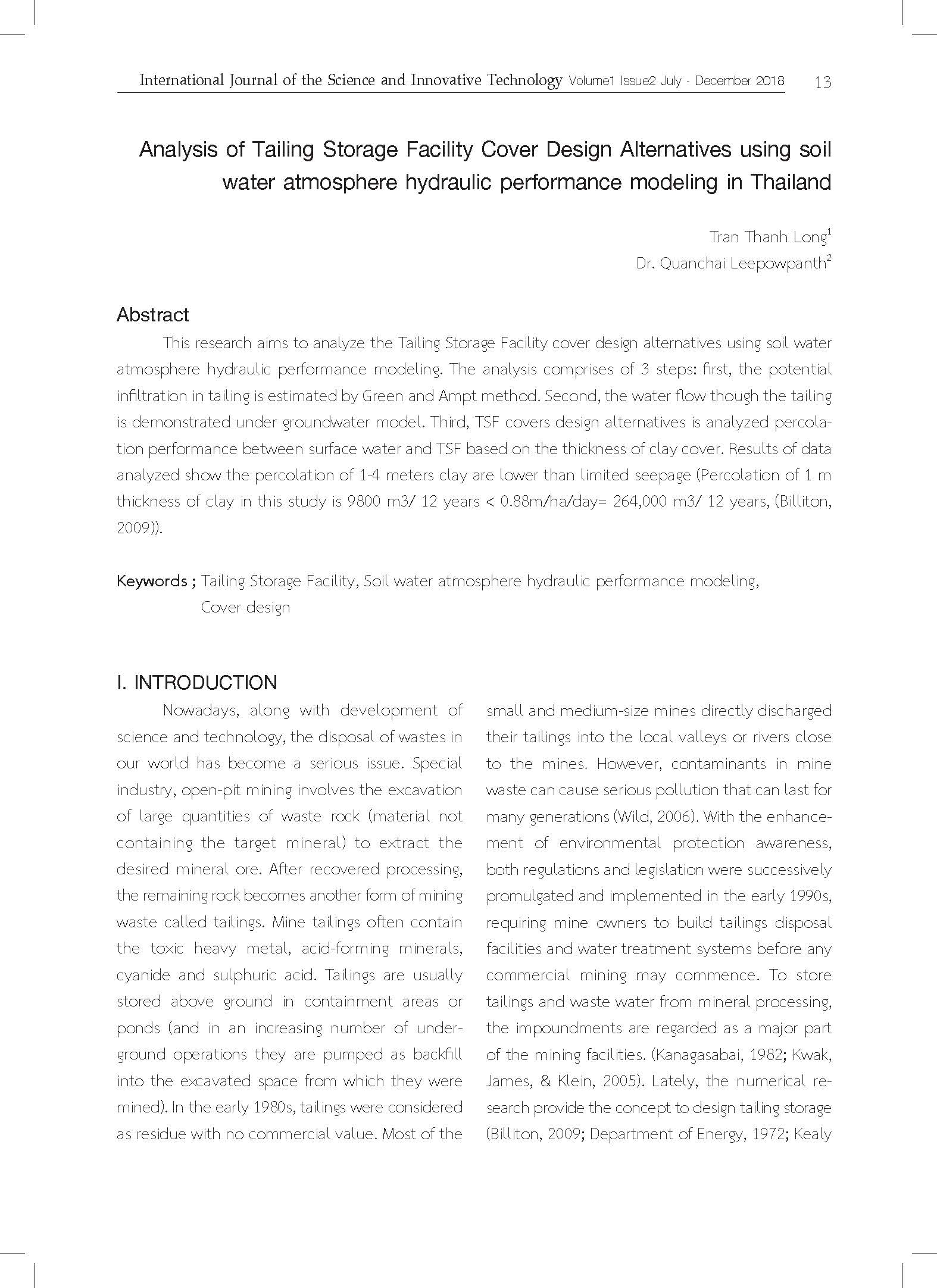Analysis of Tailing Storage Facility Cover Design Alternatives using soil water atmosphere hydraulic performance modeling in Thailand
Main Article Content
Abstract
This research aims to analyze the Tailing Storage Facility cover design alternatives using soil water
atmosphere hydraulic performance modeling. The analysis comprises of 3 steps: first, the potential
infiltration in tailing is estimated by Green and Ampt method. Second, the water flow though the tailing
is demonstrated under groundwater model. Third, TSF covers design alternatives is analyzed percolation
performance between surface water and TSF based on the thickness of clay cover. Results of data
analyzed show the percolation of 1-4 meters clay are lower than limited seepage (Percolation of 1 m
thickness of clay in this study is 9800 m3/ 12 years < 0.88m/ha/day= 264,000 m3/ 12 years, (Billiton,
2009)).
Article Details
Section
Research Article
References
Billiton, B. (2009). Olympic Dam expansion draft
environmental impact statement 2009. Retrieved
from
Department of Energy, M. a. R. C. (1972). Tentative
Design Guide for Mine Waste Embankments in
Canada. Retrieved from
Hill, M. C., Banta, E. R., Harbaugh, A. W., & Anderman, E.
R. (2000). MODFLOW-2000, the US Geological
Survey modular ground-water model; user guide
to the observation, sensitivity, and parameterestimation
processes and three post-processing
programs (2331-1258). Retrieved from
J. Rawls, W., L. Brakensiek, D., & E. Saxtonn, K. (1982).
Estimation of Soil Water Properties. Transactions
of the ASAE, 25(5), 1316-1320. doi:https://doi.
org/10.13031/2013.33720
Kanagasabai, J. (1982). ANALYSES OF FLOW FAILURES
OF MINE TAILINGS IMPOUNDMENTS.
Kealy, C. D., & Soderberg, R. L. (1969). Design of dams
for mill tailings.
Kwak, M., James, D. F., & Klein, K. A. (2005). Flow
behaviour of tailings paste for surface disposal.
International journal of mineral processing, 77(3),
139-153.
USACE-HEC. (2000). Hydrologic Modeling System HECHMS
Technical Reference Manual: US Army
Corps of Engineers, Hydrologic Engineering Center.
Wild, B. (2006). Environmental Mining Council of BC
(BC)(2006) Acid Mine Drainage: Mining and Water
Pollution Issues in BC. https://www. miningwatch.
ca/sites/www. miningwatch. ca/files/amd_0. pdf
(last accessed 4 June 2014).
environmental impact statement 2009. Retrieved
from
Department of Energy, M. a. R. C. (1972). Tentative
Design Guide for Mine Waste Embankments in
Canada. Retrieved from
Hill, M. C., Banta, E. R., Harbaugh, A. W., & Anderman, E.
R. (2000). MODFLOW-2000, the US Geological
Survey modular ground-water model; user guide
to the observation, sensitivity, and parameterestimation
processes and three post-processing
programs (2331-1258). Retrieved from
J. Rawls, W., L. Brakensiek, D., & E. Saxtonn, K. (1982).
Estimation of Soil Water Properties. Transactions
of the ASAE, 25(5), 1316-1320. doi:https://doi.
org/10.13031/2013.33720
Kanagasabai, J. (1982). ANALYSES OF FLOW FAILURES
OF MINE TAILINGS IMPOUNDMENTS.
Kealy, C. D., & Soderberg, R. L. (1969). Design of dams
for mill tailings.
Kwak, M., James, D. F., & Klein, K. A. (2005). Flow
behaviour of tailings paste for surface disposal.
International journal of mineral processing, 77(3),
139-153.
USACE-HEC. (2000). Hydrologic Modeling System HECHMS
Technical Reference Manual: US Army
Corps of Engineers, Hydrologic Engineering Center.
Wild, B. (2006). Environmental Mining Council of BC
(BC)(2006) Acid Mine Drainage: Mining and Water
Pollution Issues in BC. https://www. miningwatch.
ca/sites/www. miningwatch. ca/files/amd_0. pdf
(last accessed 4 June 2014).


